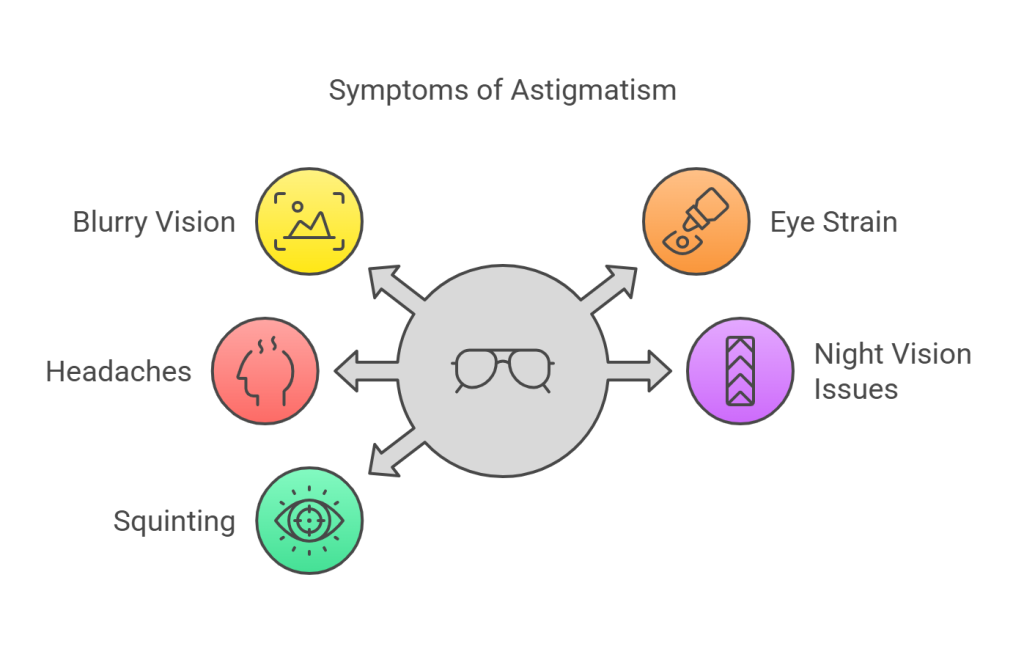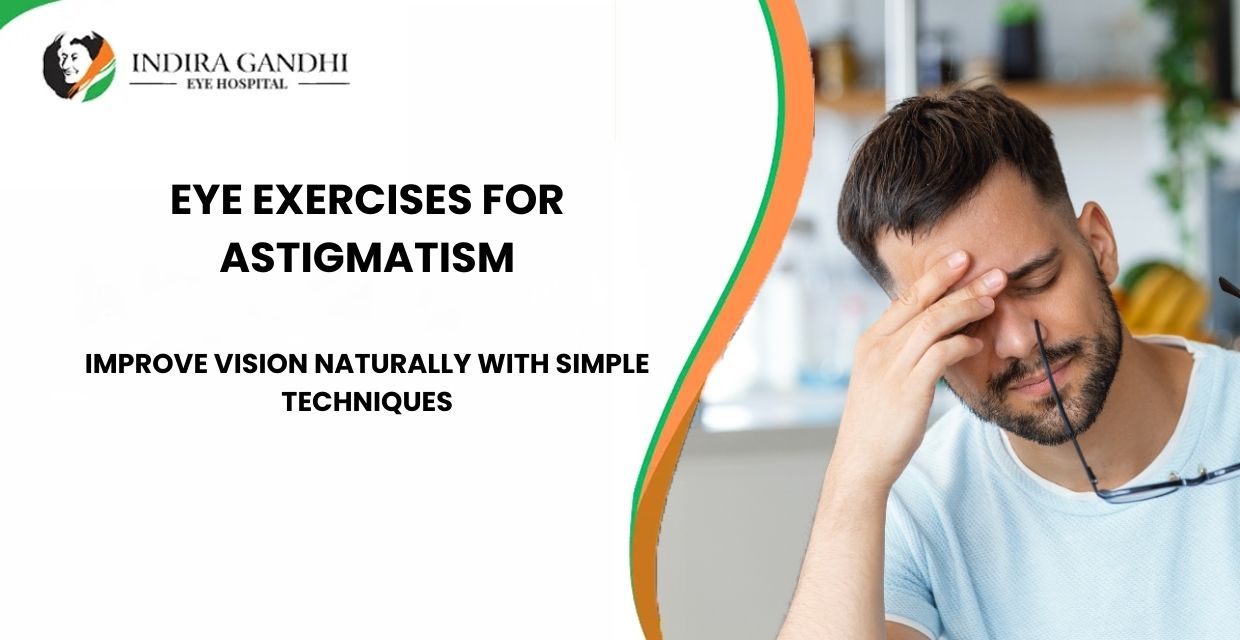|
Getting your Trinity Audio player ready...
|
Astigmatism is a common vision condition where the cornea (the clear, round dome at the front of the eye) or the lens inside the eye has an irregular shape. Instead of being perfectly round like a baseball, the cornea or lens is shaped more like a football. This shape causes blurry or distorted vision because light entering the eye doesn’t focus properly on the retina, the light-sensitive tissue at the back of the eye. Astigmatism can make it difficult to see fine details clearly, and it can affect both near and distant vision.
While astigmatism is typically corrected with glasses, contact lenses, or surgery, certain eye exercises may help improve vision naturally and reduce discomfort. These exercises are simple to do and can be performed regularly to help relieve eye strain, improve focus, and support overall eye health.
At Indira Gandhi Eye Hospital, we believe in offering comprehensive eye care to help you maintain healthy vision. In this blog, we’ll explore some effective eye exercises that may help improve astigmatism symptoms. Keep in mind that while these exercises can offer relief, they may not eliminate the need for corrective lenses or surgery, and it’s essential to consult with an eye care professional for proper treatment.
Understanding Astigmatism

Before diving into the exercises, it’s important to understand how astigmatism affects vision. The cornea or lens of an eye with astigmatism is not evenly curved, which causes light to enter the eye at different angles. As a result, the light doesn’t focus properly on the retina, leading to blurred or distorted vision. Some common symptoms of astigmatism include:
- Blurry or distorted vision at all distances
- Eye strain or fatigue
- Headaches
- Difficulty seeing clearly at night
- Squinting to see clearly
If you experience these symptoms, it’s important to get your eyes checked by a professional to confirm whether astigmatism is the cause. Fortunately, with the right treatment plan, including corrective lenses or surgery, astigmatism can be managed.
The Role of Eye Exercises in Astigmatism
While eye exercises alone cannot correct astigmatism or eliminate the need for glasses or contact lenses, they can help alleviate eye strain, improve focus, and support overall eye health. Eye exercises promote better blood circulation to the eyes and help relax the muscles responsible for focusing. In doing so, they can help reduce discomfort and may help you manage the symptoms of astigmatism more effectively.
Here are some simple and effective eye exercises you can do to improve your vision naturally. Incorporating these exercises into your daily routine can help reduce the strain caused by astigmatism and may support better visual performance.
1. Palming for Relaxation
One of the simplest and most effective eye exercises for reducing eye strain is the “palming” technique. This exercise is designed to relax your eye muscles and relieve tension that can build up throughout the day, especially if you spend long hours looking at screens.
How to do it:
- Start by sitting in a comfortable chair or standing with your back straight.
- Rub your hands together to generate heat, then gently cup your palms over your closed eyes without pressing on them.
- Let your hands rest on your face, with your fingers on your forehead and your palms covering your eyes.
- Breathe deeply and focus on the darkness and warmth created by your palms, allowing your mind and eyes to relax.
- Hold this position for about 30 seconds to 1 minute.
Why it helps: Palming helps relieve eye strain and promotes relaxation, which can be beneficial for people with astigmatism who experience discomfort from blurred vision or prolonged focusing.
2. Focus Shifting
Focus shifting is a great exercise to improve your eyes’ ability to focus on both near and distant objects. This technique strengthens the eye muscles that control focus and helps improve your vision.
How to do it:
- Sit or stand in a comfortable position with your back straight.
- Hold your finger or a small object about 6 inches away from your eyes and focus on it.
- Slowly shift your focus to an object in the distance, at least 10-15 feet away, and focus on it for a few seconds.
- Then, shift your focus back to the object in your hand or close to your face.
- Repeat this process for 2-3 minutes, focusing on each object for a few seconds at a time.
Why it helps: This exercise improves your eyes’ ability to switch focus between near and far objects. It also helps reduce strain and enhances the flexibility of your eye muscles, which can be beneficial for individuals with astigmatism.
3. The 20-20-20 Rule
One of the main reasons people with astigmatism experience eye strain is prolonged focusing on close-up objects, such as screens, books, or paperwork. To prevent this, the 20-20-20 rule is a simple yet effective way to reduce strain and improve eye comfort.
How to do it:
- Every 20 minutes, take a break from your screen or close-up work.
- Look at an object that is at least 20 feet away for 20 seconds.
- Repeat this process throughout the day.
Why it helps: This technique reduces the stress placed on your eyes when staring at a screen for long periods. It allows your eye muscles to relax and refocus, reducing strain and improving overall eye comfort.
4. Eye Rolling Exercise
Eye rolling is an excellent exercise to improve eye flexibility and strengthen the eye muscles. It helps relieve tension and encourages healthy eye movement, which can improve astigmatism symptoms.
How to do it:
- Sit or stand comfortably with your back straight.
- Slowly roll your eyes in a circular motion, first clockwise, then counterclockwise.
- Do this for 10-15 seconds in each direction, and repeat the exercise 3-5 times.
Why it helps: Eye rolling helps strengthen the muscles around the eyes and encourages the eyes to move more freely, which is important for those with astigmatism.
5. Figure 8 Exercise
The figure 8 exercise is designed to improve the flexibility of your eye muscles and increase your ability to focus smoothly. This exercise helps to relax the eye muscles and can be especially beneficial for individuals with astigmatism.
How to do it:
- Sit comfortably in a chair with your back straight.
- Focus on an imaginary point in front of you, and visualize the number “8” in front of you.
- Slowly trace the figure 8 with your eyes, moving your gaze in the shape of the number.
- Perform this exercise for 1-2 minutes, switching directions halfway through.
Why it helps: This exercise helps improve coordination and control over eye movements, which can reduce the strain caused by astigmatism.
6. Blinking Exercise
Blinking is a natural way for your eyes to refresh and maintain moisture. However, many people tend to blink less often when focusing on a screen, leading to dry eyes and discomfort. The blinking exercise can help reduce this issue and promote healthy tear production.
How to do it:
- Sit comfortably and relax.
- Close your eyes gently, and then open them slowly.
- Blink rapidly 10 times, then close your eyes and rest for 5 seconds.
- Repeat this process 2-3 times.
Why it helps: Regular blinking helps lubricate the eyes and relieve dryness, which is a common issue for people with astigmatism who spend long hours looking at screens or reading.
7. Pencil Push-Ups
The pencil push-up exercise is an excellent way to improve focus and help strengthen the eye muscles, which can be especially useful for individuals with astigmatism who struggle with clear vision at both near and far distances.
How to do it:
- Hold a pencil or any small object at arm’s length, in front of your eyes.
- Focus on the text or logo on the pencil and slowly move it toward your nose.
- Keep your focus on the object as long as possible. If your focus breaks and you see double, stop and return the pencil to arm’s length.
- Repeat the exercise for 2-3 minutes.
Why it helps: This exercise improves your convergence (the ability of your eyes to move together to focus on a close object), which is particularly beneficial for people with astigmatism.
Improve Astigmatism Naturally with Easy Eye Exercises!
Make An AppointmentConclusion: Take Care of Your Eyes with Indira Gandhi Eye Hospital
While eye exercises may help alleviate some of the symptoms of astigmatism and improve overall eye health, it’s important to remember that they are not a substitute for professional eye care. If you have astigmatism or any other vision problems, it’s essential to schedule a comprehensive eye exam with a qualified ophthalmologist.
At Indira Gandhi Eye Hospital, we specialize in diagnosing and treating a variety of vision conditions, including astigmatism. Our team of experienced doctors and staff are dedicated to providing you with the highest quality of care to help you maintain healthy, clear vision.
If you’re experiencing any issues with your vision or would like to learn more about how to manage astigmatism, feel free to contact us at Indira Gandhi Eye Hospital. Our team is here to help guide you on your journey to better eye health.












